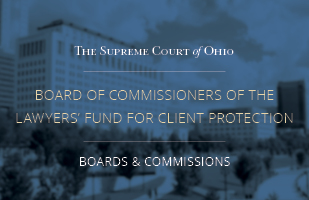Lawyers’ Fund for Client Protection: Righting the Wrongs

The Lawyers’ Fund has helped thousands of people and returned tens of millions of dollars since its inception in 1985.

The Lawyers’ Fund has helped thousands of people and returned tens of millions of dollars since its inception in 1985.
Editor’s Note: This story is part of a series on the Ohio Supreme Court’s boards and commissions.
The legal profession prides itself as a standard-bearer for ethical practice. That includes self-monitoring the profession by disciplining lawyers for misconduct and aiding victims of attorney theft.The Lawyers’ Fund for Client Protection’s sole mission is to help people who lost money or property to a dishonest attorney.
Created by the Ohio Supreme Court in 1985 as a means to promote public confidence in the legal profession, the entity handles law clients’ claims seeking reimbursement from lawyers accused of misappropriating, converting, or even stealing assets.
“The most common claim is an unearned fee,” said Janet Green Marbley, the fund’s administrator and the secretary of its board of commissioners.
“These are claims where the lawyer receives a fee but fails to provide the services requested and fails to refund the fee.”
Other theft categories include taking money from escrow, an estate, a settlement, or from a trust as a fiduciary.
The Money Trail
With the department since 1995, Green Marbley, along with her three staff members and the fund’s board of commissioners, is responsible for overseeing the pool of money allocated for these claims, as dictated by Rule VIII in the Supreme Court’s Rules for the Government of the Bar of Ohio.
Funds for the payment of claims are allocated from attorney registration fees. Once a claim is determined eligible for reimbursement, the Lawyer’s Fund will pay the individual directly, and then try to recoup the money from the offending attorney.
The maximum award a victim can receive is $100,000.
If the attorney doesn’t make restitution, or isn’t cooperative, the fund continues its pursuit of repayment, which can include assistance from the Ohio Attorney General’s Office.
Eligibility Essential
In order for a person to be eligible for reimbursement, the lawyer must be sanctioned by the Ohio Supreme Court for misconduct. That discipline stems from information gathered through a process that includes investigations by Office of Disciplinary Counsel and hearings before the Ohio Board of Professional Conduct.
“The majority of lawyers represent their clients ethically and professionally, but the damage inflicted by a few dishonest attorneys is extremely harmful to the profession,” Green Marbley said.
Claims filed prior to disciplinary action against the lawyer are held until that process is completed.
Understanding the Process
Claim applications are initially filtered by the fund’s administrative secretary – in consultation with the administrator – to determine whether they meet the threshold to begin an investigation.
The claims analyst investigates to verify the claimants’ allegations. Key evidence sought are receipts and documents that specify the exact amount of money lost during the lawyer’s representation.
The results of the investigation are reviewed by the administrator and a report is prepared for the fund’s seven commissioners to review at its quarterly meetings.
“We try to do everything we can to make their job as easy as possible,” said Green Marbley.
In recent years, the average number of claims reviewed at each meeting is around 10 to 20. A majority rule of four votes is required for reimbursement. The board also decides the amount awarded to the victim.
Many disciplinary cases against an attorney accused of theft include a restitution order, which specifies how much a client should be compensated.
Both lawyers and claimants can request reconsideration of the board’s determination. They may also ask for a live hearing before the fund’s commissioners, which Green Marbley says has happened only a handful of times.
Depending on the related disciplinary proceedings, the fund’s timeline from start to finish typically takes at least a year.
The Lawyer’s Fund makes its decisions public through news releases, which are published by Court News Ohio.
Board of Varied Viewpoints
The seven commissioners, appointed by the Supreme Court to serve three-year commitments with the option to serve two consecutive terms, must include one non-attorney.
“The public is best served by a diverse board, including practice area, location, gender, and race” Green Marbley said. “It works and helps to meet the fund’s mission and purpose.”
Thousands of Clients Helped, Millions of Dollars Returned
In its most recent annual report, the Lawyer’s Fund awarded more than $503,000 to 56 victims, who were represented by 24 attorneys.
Those numbers are significantly down from the previous five years, which averaged more than $764,000 to 136 clients from 41 attorneys.
In its decades of service, the fund has assisted thousands of clients and returned tens of millions of dollars, thanks to the dedication of the LFCP staff and its board.
Green Marbley, who worked as counsel for the state attorney general and a legal aid lawyer prior to her appointment by the Court, says the profound impact the fund has on so many lives is more rewarding than anything she’s done in her legal career.
“I enjoy what I do, and I enjoy helping people,” she said.
Service on the Board of Commissioners of the Lawyers’ Fund for Client Protection is one of the many ways an attorney can give back to the profession. The Board of Commissioners of the Lawyers’ Fund for Client Protection, like other boards and commissions, has a need for volunteers to share in maintaining the integrity of the profession. The justices of the Ohio Supreme Court appoint the members of the board and are always grateful for applications from those willing to serve.


